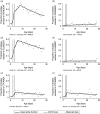The changing antibiotic susceptibility of bloodstream infections in the first month of life: informing antibiotic policies for early- and late-onset neonatal sepsis
- PMID: 23842441
- PMCID: PMC9151171
- DOI: 10.1017/S0950268813001520
The changing antibiotic susceptibility of bloodstream infections in the first month of life: informing antibiotic policies for early- and late-onset neonatal sepsis
Abstract
This study describes the association between antibiotic resistance of bacteria causing neonatal bloodstream infection (BSI) and neonatal age to inform empirical antibiotic treatment guidelines. Antibiotic resistance data were analysed for 14 078 laboratory reports of bacteraemia in neonates aged 0-28 days, received by the Health Protection Agency's (now Public Health England) voluntary surveillance scheme for England and Wales between January 2005 and December 2010. Linear and restricted cubic splines were used in logistic regression models to estimate the nonlinear relationship between age and resistance; the significance of confounding variables was assessed using likelihood ratio tests. An increase in resistance in bacteria causing BSI in neonates aged <4 days was observed, which was greatest between days 2-3 and identified an age (4-8 days, depending on the antibiotic) at which antibiotic resistance plateaus to almost unchanging levels. Our results indicate important age-associated changes in antibiotic resistance and support current empirical treatment guidelines.
Figures


Similar articles
-
Neonatal bloodstream infections in a Ghanaian Tertiary Hospital: Are the current antibiotic recommendations adequate?BMC Infect Dis. 2016 Oct 24;16(1):598. doi: 10.1186/s12879-016-1913-4. BMC Infect Dis. 2016. PMID: 27776490 Free PMC article.
-
Empirical treatment of neonatal sepsis: are the current guidelines adequate?Arch Dis Child Fetal Neonatal Ed. 2011 Jan;96(1):F4-8. doi: 10.1136/adc.2009.178483. Epub 2010 Jun 28. Arch Dis Child Fetal Neonatal Ed. 2011. PMID: 20584804
-
Bacteriological profile, antibiotic susceptibility and factors associated with neonatal Septicaemia at Kilembe mines hospital, Kasese District Western Uganda.BMC Microbiol. 2021 Nov 4;21(1):303. doi: 10.1186/s12866-021-02367-z. BMC Microbiol. 2021. PMID: 34736415 Free PMC article.
-
Bacterial pathogens and resistance causing community acquired paediatric bloodstream infections in low- and middle-income countries: a systematic review and meta-analysis.Antimicrob Resist Infect Control. 2019 Dec 30;8:207. doi: 10.1186/s13756-019-0673-5. eCollection 2019. Antimicrob Resist Infect Control. 2019. PMID: 31893041 Free PMC article.
-
High Reported Rates of Antimicrobial Resistance in Indian Neonatal and Pediatric Blood Stream Infections.J Pediatric Infect Dis Soc. 2017 Sep 1;6(3):e62-e68. doi: 10.1093/jpids/piw092. J Pediatric Infect Dis Soc. 2017. PMID: 28339675 Review.
Cited by
-
Antimicrobial therapy in neonatal intensive care unit.Ital J Pediatr. 2015 Apr 1;41:27. doi: 10.1186/s13052-015-0117-7. Ital J Pediatr. 2015. PMID: 25887621 Free PMC article. Review.
-
Population-based study of early-onset neonatal sepsis in Canada.Paediatr Child Health. 2019 May;24(2):e66-e73. doi: 10.1093/pch/pxy018. Epub 2018 Apr 24. Paediatr Child Health. 2019. PMID: 30996609 Free PMC article.
-
Membership and behavior of ultra-low-diversity pathogen communities present in the gut of humans during prolonged critical illness.mBio. 2014 Sep 23;5(5):e01361-14. doi: 10.1128/mBio.01361-14. mBio. 2014. PMID: 25249279 Free PMC article.
-
Antimicrobial Proteins and Peptides in Early Life: Ontogeny and Translational Opportunities.Front Immunol. 2016 Aug 18;7:309. doi: 10.3389/fimmu.2016.00309. eCollection 2016. Front Immunol. 2016. PMID: 27588020 Free PMC article. Review.
-
Antimicrobial Peptides in Early-Life Host Defense, Perinatal Infections, and Necrotizing Enterocolitis-An Update.J Clin Med. 2022 Aug 29;11(17):5074. doi: 10.3390/jcm11175074. J Clin Med. 2022. PMID: 36079001 Free PMC article. Review.
References
-
- Bryce J, et al. WHO estimates of the causes of death in children. Lancet 2005; 365: 1147–1152. - PubMed
-
- Adams-Chapman I, Stoll BJ. Neonatal infection and long-term neurodevelopmental outcome in the preterm infant. Current Opinion in Infectious Diseases 2006; 19: 290–297. - PubMed
-
- Leibovici L, Paul M. Benefit associated with appropriate antibiotic treatment. Clinical Infectious Diseases 2007; 45: 1400–1402. - PubMed
-
- Muller-Pebody B, et al. Empirical treatment of neonatal sepsis: are the current guidelines adequate? Archives of Disease in Childhood – Fetal and Neonatal Edition 2011; 96: F4–8. - PubMed
MeSH terms
Substances
LinkOut - more resources
Full Text Sources
Other Literature Sources
Medical

